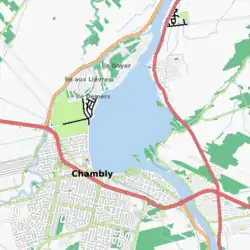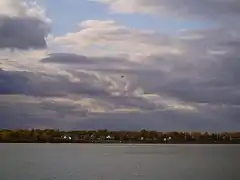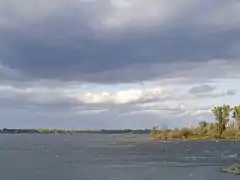Bassin-de-Chambly
The Bassin de Chambly (English: Chambly Basin) is a waterbody formed by an enlargement of the Richelieu River, which extends at the foot of the rapids of Chambly, in the administrative region of Montérégie, south of the province of Quebec, in Canada. This basin straddles the regional county municipalities (MRC) of:
- Rouville Regional County Municipality: cities of Richelieu and municipality of Saint-Mathias-sur-Richelieu;
- La Vallée-du-Richelieu: city of Carignan and city of Chambly.
| Bassin de Chambly | |
|---|---|
 | |
 Bassin de Chambly | |
| Location | Chambly, Montérégie, Quebec, Canada |
| Coordinates | 45°27′40″N 73°17′00″W |
| Primary inflows | (clockwise) ruisseau Wilson, rivière des Hurons, Richelieu River, Chambly Canal |
| Primary outflows | Richelieu River |
| Basin countries | Canada |
| Max. length | 1.98 mi (3.18 km) |
| Max. width | 1.34 mi (2.16 km) |
| Residence time | years |
| Surface elevation | 11 to 100 ft (3.4 to 30.5 m) |
| Settlements | Richelieu, Saint-Mathias-sur-Richelieu, Carignan and Chambly |
The Chambly Basin is an important area for recreational tourism activities including boating, vacationing, hotels and historic aspects, notably thanks to the Chambly Canal National Historic Site of Canada.
The surface of the basin is generally frozen from mid-December to the end of March. Safe traffic on the ice is generally from late December to early March. The water level of the river varies with the seasons and the precipitation.
Geography
The shape of the basin is similar to the shape of a football. The current from the Richelieu River arrives from the southeast by crossing the Chambly rapids for a length of approximately 1.35 kilometres (0.84 mi), i.e. downstream from the Yule bridge which spans this river in order to connect Chambly (west bank) and Richelieu (east bank). These rapids end at the height of an archipelago of small islands bordering the south-eastern shore of the basin.
The Rivière des Hurons flows toward the middle of the eastern shore of the basin. The Chambly Canal pours its waters on the south shore of the basin, in the area of the Chambly Canal National Historic Site of Canada.
The western part of the basin includes Île aux Lièvres, Demers Island (residential area), Île au Foin and Goyer Island (residential area). Channels separate these islands. These islands are part of the territory of the city of Carignan. The Acadia River which runs on the west side of Chambly drains at the northeast point of Goyer Island, that is 1.0 kilometre (0.62 mi) downstream of the limit north of the Chambly basin.[1]
History
Samuel de Champlain, the first white man to see this sheet of water, in 1609, writes: "The entrance to the jump is a kind of lake, where the water goes down, which contains some three circuit leagues.[2]
In Jesuit Relations of 1665, we read: "This basin is like a small lake, a league and a half of a turn, six to eight feet deep.[3] "
Toponym
The credits are used to describe the shallow basin of the “lake” in which alluvium is deposited. The specific refers to the seigneury of Chambly whose basin is at the geographic center.[4]"
The toponym "Chambly basin" was formalized on December 5, 1968 at the Place Names Bank of the Commission de toponymie du Québec.[4]
Image gallery

Chambly basin 
Rapides de Chambly
Notes and references
See also
- Rouville Regional County Municipality
- La Vallée-du-Richelieu Regional County Municipality
- Richelieu
- Saint-Mathias-sur-Richelieu
- Carignan
- Chambly
- Richelieu River
- Rivière des Hurons
- Chambly Canal
- Fort Chambly
- Goyer Island
- Île aux Lièvres
- Demers Island
- Seigneurie de Chambly
- List of lakes of Montérégie